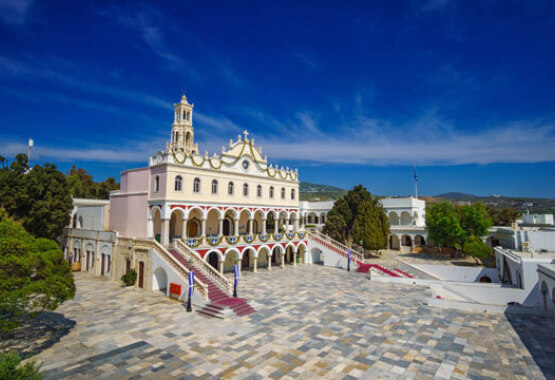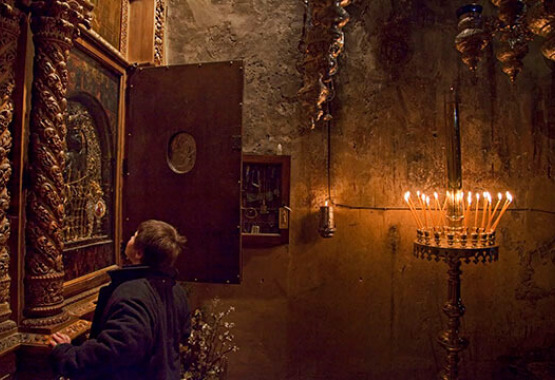
AROUND GREECE
But what is it that really connects three illustrious monasteries so far away from each other? What can Nea Moni (the New Monastery) on the island of Chios, Dafni Monastery near Athens, and the Monastery of Hosios Loukas (the Venerable Luke) in Voiotia possibly have in common? Well, all three of them are on the UNESCO World Heritage list. But the relationship between them runs deeper. All three of these historic monasteries are decorated with the greatest mosaic masterpieces of late Byzantine times. Precious tesserae create explosions of light, composing complex worlds of colour in these places of holy worship. These artists have created mosaics which leave both art historians and travellers speechless; they are a breathtaking expression of devotion and holy celebration.
The devout monks told the exiled Emperor Constantine IX Monomachos about this sign from God. Constantine promised to have the monastery put under his protection, and sealed the promise by giving the monks his princely ring. Immediately after his restoration to the throne of the Byzantine Empire, he erected Nea Moni of Chios, summoning an army of the greatest master craftsmen, marble sculptors and icon painters for this purpose. Since then Nea Moni of Chios has ornamented the heart of the island, 12 km west of the town.
Romanos IV Diogenes, who succeeded Constantine and later Theodora as emperor, always kept the Monastery under his protection. The concern of the throne for the monastery proved constant for as long as the Byzantine Empire was to last.
The “katholikon” (main church) of the Monastery has an octagonal design, which in the 11th century when it was built, was a pioneering architectural feature. Elaborately decorated with semi-transparent white and purple marble, with exquisite mosaic ornamentation, the majestic splendour it exudes makes it one of the most representative samples of the imperial sacred art and architecture.
Within the monastery grounds there are two other chapels, one dedicated to Agios Panteleimon (St. Panteleimon) and Timios Stavros (the Holy Cross). During the period that the monastery functioned as a male priory, women were not allowed access. The two chapels held services for female pilgrims, who were not allowed access to the main church.
The main site of the monastery houses the monks' cells, the refectory (‘trapeza’), which was erected between 1631 and 1637, the underground water cistern (‘kinsterna’), an 11th century construction, and the imposing defensive tower, which was built in the 14th century.
Nea Moni of Chios, its architecture as a whole, the unique relics it houses and the peace and quiet of the surrounding area make it a real treasure in the heart of the island of Chios.
The traveller arriving here will face the image of Pantokrator (God Almighty), a masterful religious mosaic. It is impossible for the camera lens to capture the spirituality, the power and the glory of the light emanating from the figure of Christ in the dome of the monastery’s ‘katholikon’ (main church).
Like Nea Moni of Chios, the architecture of the church is octagonal. The monastery was built in the 11th century and in its thousand year history it has enjoyed periods of great prosperity. The complex is protected by strong fortifications and towers.
The Monastery of Dafni is open to visitors. This is a place where beauty contributes in synergy with the quietness of the surroundings, creating a fascinating amalgam of forces.
The monastery church dedicated to the Virgin Mary was the only one built in mainland Greece in the 10th century. The main ‘katholikon’, dedicated to Οsios Loukas, also has an octagonal architectural design, like Nea Moni of Chios and the Monastery of Dafni. The sublime mosaic ornamentation, the bright marble and the golden chandeliers all bear witness to the high regard in which the monastery was held during the late Byzantine period. Since that time it has been a much venerated shrine, waiting for travellers to be their guide through the enchanting legends and secret pathways of Byzantine history.
Monasteries on the UNESCO World heritage list
There is a direct link between religion as a cultural phenomenon and tourism. Religion in terms of tourism is based on the clear cultural bedrock of tradition. Greeks and foreign visitors are stunned by Greece’s majestic monasteries and churches of the Byzantine era, countless rural churches and metochia (monastery grounds and gardens), sacred places of pilgrimage and religious sites, all of which inspire awe.But what is it that really connects three illustrious monasteries so far away from each other? What can Nea Moni (the New Monastery) on the island of Chios, Dafni Monastery near Athens, and the Monastery of Hosios Loukas (the Venerable Luke) in Voiotia possibly have in common? Well, all three of them are on the UNESCO World Heritage list. But the relationship between them runs deeper. All three of these historic monasteries are decorated with the greatest mosaic masterpieces of late Byzantine times. Precious tesserae create explosions of light, composing complex worlds of colour in these places of holy worship. These artists have created mosaics which leave both art historians and travellers speechless; they are a breathtaking expression of devotion and holy celebration.
Nea Moni, Chios – one vision and three emperors
In the 11th century AD the ascetics Nikitas, Ioannis (John) and Iosif (Joseph), who practiced a monastic life on the Provateio Mountain of Chios, had a common vision. It was of the image of the Virgin, insisting that her icon be returned to where it had been discovered, signalling the location where Palaia Moni (the Old Monastery) of Chios should be built.The devout monks told the exiled Emperor Constantine IX Monomachos about this sign from God. Constantine promised to have the monastery put under his protection, and sealed the promise by giving the monks his princely ring. Immediately after his restoration to the throne of the Byzantine Empire, he erected Nea Moni of Chios, summoning an army of the greatest master craftsmen, marble sculptors and icon painters for this purpose. Since then Nea Moni of Chios has ornamented the heart of the island, 12 km west of the town.
Romanos IV Diogenes, who succeeded Constantine and later Theodora as emperor, always kept the Monastery under his protection. The concern of the throne for the monastery proved constant for as long as the Byzantine Empire was to last.
The “katholikon” (main church) of the Monastery has an octagonal design, which in the 11th century when it was built, was a pioneering architectural feature. Elaborately decorated with semi-transparent white and purple marble, with exquisite mosaic ornamentation, the majestic splendour it exudes makes it one of the most representative samples of the imperial sacred art and architecture.
Within the monastery grounds there are two other chapels, one dedicated to Agios Panteleimon (St. Panteleimon) and Timios Stavros (the Holy Cross). During the period that the monastery functioned as a male priory, women were not allowed access. The two chapels held services for female pilgrims, who were not allowed access to the main church.
The main site of the monastery houses the monks' cells, the refectory (‘trapeza’), which was erected between 1631 and 1637, the underground water cistern (‘kinsterna’), an 11th century construction, and the imposing defensive tower, which was built in the 14th century.
Nea Moni of Chios, its architecture as a whole, the unique relics it houses and the peace and quiet of the surrounding area make it a real treasure in the heart of the island of Chios.
The Dafni Monastery – the power and the beauty
The Dafni Monastery is located on the outskirts of Alsos Chaidari (Chaidari Grove), 11 km west of Athens, on the main arterial road which has, since ancient times, connected Elefsina (Eleusis) with the capital city of Greece. The area around the monastery and within the courtyard exudes serenity and a powerful presence.The traveller arriving here will face the image of Pantokrator (God Almighty), a masterful religious mosaic. It is impossible for the camera lens to capture the spirituality, the power and the glory of the light emanating from the figure of Christ in the dome of the monastery’s ‘katholikon’ (main church).
Like Nea Moni of Chios, the architecture of the church is octagonal. The monastery was built in the 11th century and in its thousand year history it has enjoyed periods of great prosperity. The complex is protected by strong fortifications and towers.
The Monastery of Dafni is open to visitors. This is a place where beauty contributes in synergy with the quietness of the surroundings, creating a fascinating amalgam of forces.
The Monastery of Hosios Loukas – the hermit of Helicon
The Monastery of Οsios Loukas in Voiotia is dedicated to a hermit who was born, lived and died in the shadow of Mount Helicon in the 10th century, known as Venerable Luke the Stiriote (Οsios Loukas Steiriotis). The monastery is built on the site of an ancient temple dedicated to the worship of the goddess Demeter Steiritida.The monastery church dedicated to the Virgin Mary was the only one built in mainland Greece in the 10th century. The main ‘katholikon’, dedicated to Οsios Loukas, also has an octagonal architectural design, like Nea Moni of Chios and the Monastery of Dafni. The sublime mosaic ornamentation, the bright marble and the golden chandeliers all bear witness to the high regard in which the monastery was held during the late Byzantine period. Since that time it has been a much venerated shrine, waiting for travellers to be their guide through the enchanting legends and secret pathways of Byzantine history.


